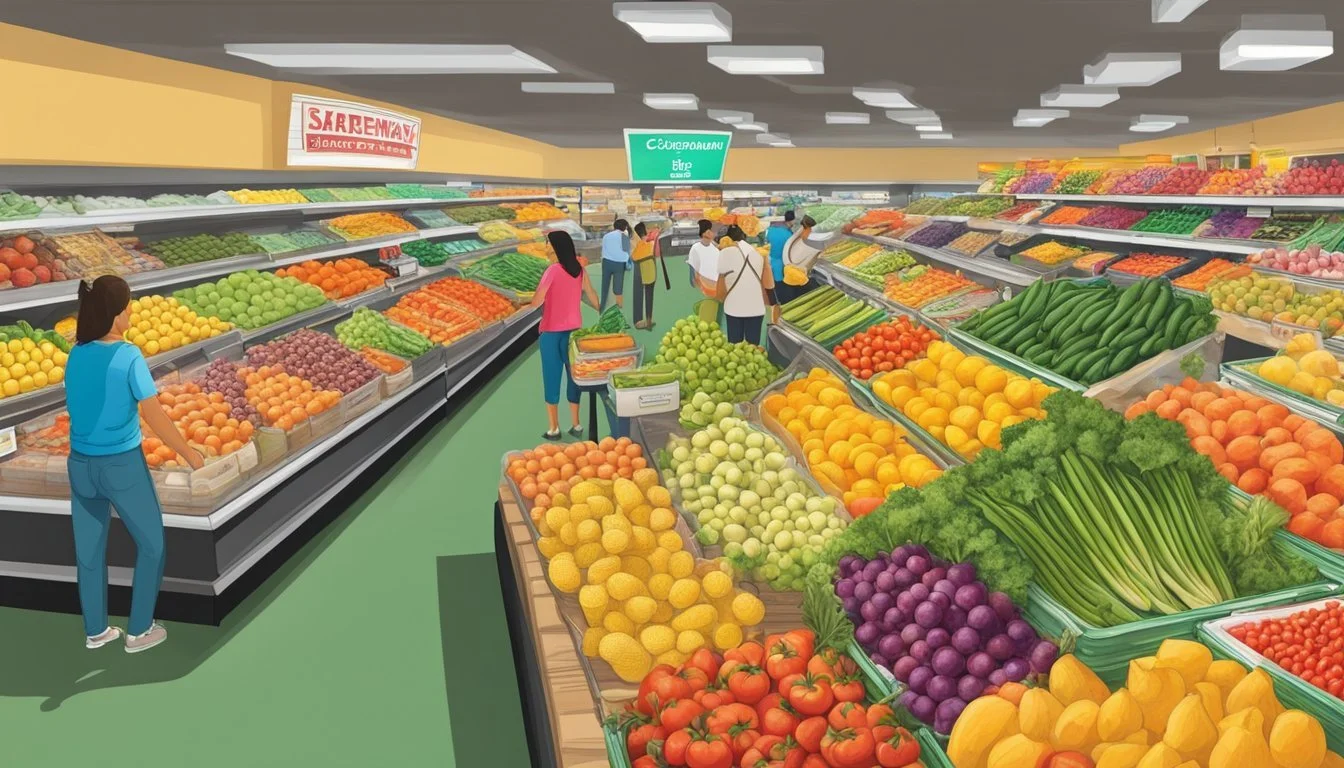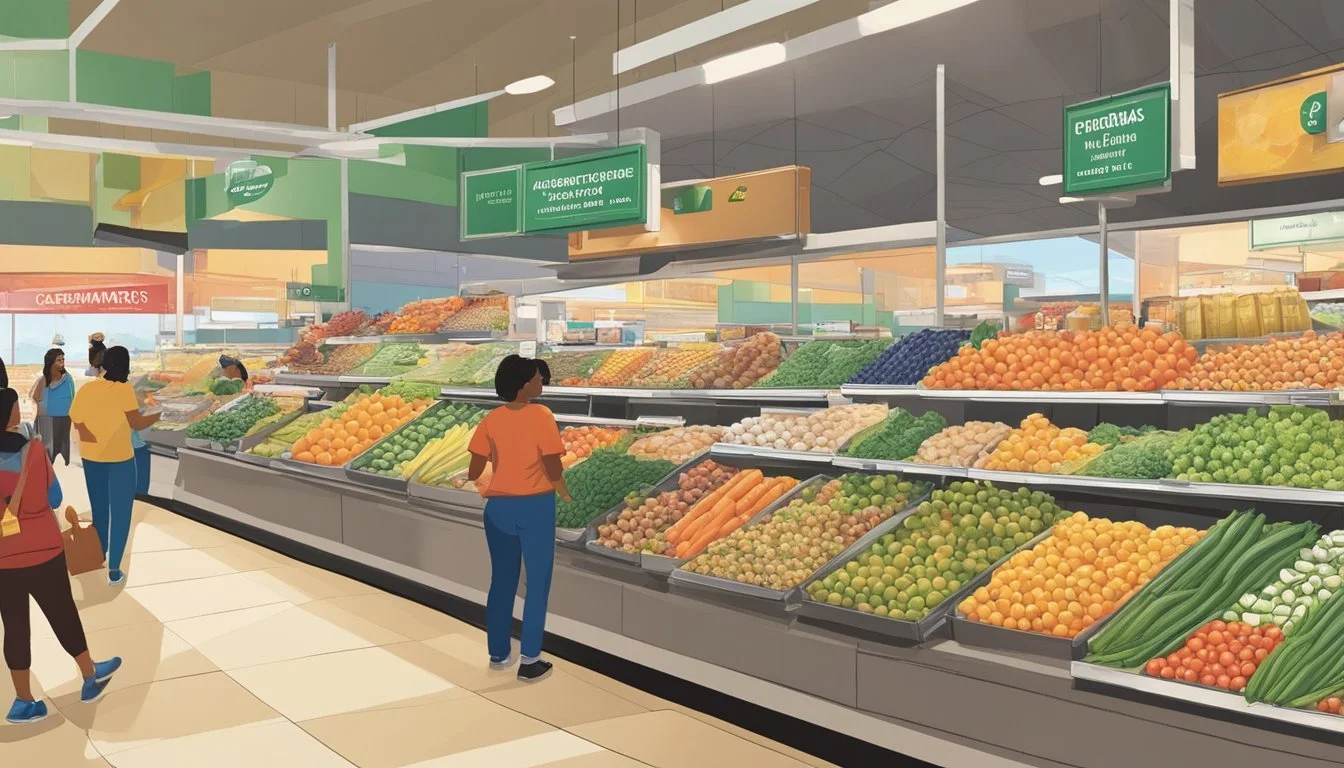Is Cardenas Markets Cheaper Than Safeway?
A Price Comparison of Two Popular Grocery Chains
When it comes to grocery shopping in the Bay Area, many consumers are looking for ways to stretch their budgets. Cardenas Markets and Safeway are two popular options, but which one offers better prices?
Cardenas Markets generally provides more affordable prices than Safeway, especially for produce and ethnic foods. This Mexican-American supermarket chain is known for its competitive pricing on fruits, vegetables, and specialty items. Shoppers often find significant savings on staples like rice, beans, and tortillas compared to mainstream supermarkets.
Safeway, while offering a wider selection of products and convenient locations, typically has higher prices across most categories. However, savvy shoppers can still find deals at Safeway through promotional offers, loyalty programs, and store-brand products. For those seeking the best overall value, comparing prices and shopping strategically at both stores may yield the greatest savings.
Comparing Cardenas Markets and Safeway
Cardenas Markets and Safeway offer distinct shopping experiences with varying price points and product selections. Their differences span multiple categories, from produce to meat to store brands.
Price Comparison Overview
Cardenas Markets generally offers lower prices than Safeway on many items. This price advantage is particularly noticeable in the produce section. A typical shopping basket at Cardenas can cost 10-15% less than at Safeway.
However, prices can fluctuate based on seasonal availability and local market conditions. Some specialty items may be priced similarly at both stores.
Impact of Location on Prices
Store locations significantly influence pricing strategies. Cardenas Markets in areas with higher Hispanic populations often have more competitive prices on Latin American products.
Safeway stores in urban centers or affluent neighborhoods may have slightly higher prices compared to their suburban counterparts. This reflects differences in operational costs and local market dynamics.
Rural Safeway locations sometimes offer lower prices due to reduced overhead expenses.
Variety and Quality of Produce
Cardenas Markets excels in offering a wide variety of fresh produce, particularly Hispanic and tropical fruits and vegetables. Their produce is often priced lower than Safeway's.
Safeway provides a more standardized produce selection across its stores. While their quality is generally good, it may not match the freshness of Cardenas' offerings in some categories.
Both stores strive to maintain quality standards, but Cardenas often edges out Safeway in terms of produce freshness and variety.
Prices of Meat and Seafood
Cardenas Markets typically offers lower prices on various cuts of meat, especially those popular in Latin American cuisine. Their meat department features a wider selection of these cuts.
Seafood prices at Cardenas are often more competitive, particularly for varieties common in Hispanic dishes.
Safeway's meat and seafood prices tend to be higher, but they frequently run sales and promotions. Their selection caters more to mainstream American preferences.
Cost of Organic Produce
Safeway generally has a broader selection of organic produce compared to Cardenas Markets. However, this comes at a premium price.
Cardenas offers some organic options, usually at lower prices than Safeway. Their organic selection is more limited but growing.
Price differences for organic items between the two stores can range from 10% to 30%, with Cardenas being the more affordable option when available.
Grocery Store Brands and Generic Staples
Safeway's store brand, "Signature Select," covers a wide range of products. These items are typically priced lower than national brands but higher than Cardenas' generic options.
Cardenas Markets offers its own line of generic products, often at significantly lower prices than Safeway's store brand or national brands.
Common staples like rice, beans, and cooking oil are usually cheaper at Cardenas. Safeway's generic staples are competitively priced but generally not as low as Cardenas'.
Both stores frequently run promotions on their store brands, but Cardenas' base prices tend to be lower.
Discounts and Savings
Cardenas Markets and Safeway both offer various ways for customers to save money on groceries. These include weekly sales, loyalty programs, and store brand options.
Sale Prices and Loss Leaders
Cardenas Markets runs weekly specials on popular items, often featuring fresh produce and meats. They advertise these deals in store flyers and online. Safeway also provides weekly sales across departments, including pantry staples and household goods. Both chains use loss leaders - deeply discounted items to attract customers. Safeway tends to have more extensive sales circulars with a wider range of products on promotion each week. Cardenas focuses its deepest discounts on Hispanic food staples and fresh items. Savvy shoppers can save significantly by planning meals around sale items at either store.
Loyalty Programs and Savings Cards
Safeway offers the free Club Card program, providing member-only discounts on hundreds of items each week. Cardholders also earn points on purchases to redeem for gas savings. Cardenas Markets has the Amigo Card, which gives shoppers access to digital coupons and exclusive deals. The Amigo Card doesn't have a points system but does provide birthday rewards. Safeway's program is more robust, with personalized deals based on purchase history. Both loyalty programs are free to join and can lead to substantial savings for regular customers.
Comparison of Store Brands
Safeway's Signature Select and O Organics lines cover a wide range of products at lower prices than national brands. These store brands are generally 10-30% cheaper. Cardenas Markets offers its Cardenas brand on select items, mainly in Hispanic food categories. The selection is more limited but provides good value on authentic products. Safeway's store brand line is more extensive, covering nearly every category in the store. Quality tends to be comparable between store and national brands at both chains, making them a smart choice for budget-conscious shoppers.
Customer Experience
Cardenas Markets and Safeway offer distinct customer experiences that reflect their target demographics and business models. Key differences emerge in service quality, store environments, and operational aspects.
Customer Service Reviews
Cardenas Markets receives positive feedback for its friendly staff and cultural authenticity. Employees often speak Spanish, catering to Hispanic customers. Reviews highlight the helpful nature of workers in locating specialty items.
Safeway garners mixed reviews. Some customers praise the professional and efficient service. Others report inconsistent experiences across different locations. Safeway's larger size sometimes leads to less personalized interactions.
Both chains have loyalty programs. Cardenas' program focuses on cultural products and events. Safeway's app offers digital coupons and personalized deals based on shopping history.
Store Amenities and Environment
Cardenas Markets emphasizes a vibrant, colorful atmosphere. Stores feature:
In-house tortillerias
Fresh produce sections with Hispanic fruits and vegetables
Prepared food counters with traditional dishes
Bakeries offering pan dulce and other Latin pastries
Safeway stores typically have a more standardized layout. Common amenities include:
Pharmacies
Starbucks kiosks
Deli and bakery sections
Self-checkout lanes
Cardenas tends to be noisier and more lively. Safeway aims for a quieter, more organized shopping experience.
Checkout Efficiency and Hours of Operation
Cardenas Markets often face busy periods, especially on weekends. Lines can be long during peak hours. Many locations operate from 6 AM to 11 PM daily.
Safeway generally offers faster checkout times due to:
More lanes
Self-checkout options
Updated point-of-sale systems
Most Safeway stores have longer hours, with many open 24/7. This provides greater flexibility for shoppers with varied schedules.
Both chains have implemented online ordering and pickup services. Safeway's more extensive digital infrastructure often results in smoother online experiences.
Shopping Convenience
Cardenas Markets and Safeway offer different shopping experiences in terms of convenience. Their store locations, delivery options, and prepared food selections cater to varying customer needs and preferences.
Accessibility and Store Locations
Cardenas Markets primarily serves Hispanic communities with over 50 stores across California, Nevada, and Arizona. Their locations are strategically placed in areas with significant Latino populations. Safeway, on the other hand, boasts a larger national presence with over 900 stores spread across 17 states and the District of Columbia.
Safeway's wider distribution provides easier access for many shoppers. However, Cardenas Markets offers a more specialized shopping experience for those seeking authentic Hispanic products.
Grocery Delivery Options
Safeway provides comprehensive online ordering and delivery services through their website and mobile app. Customers can choose home delivery or store pickup options for added flexibility.
Cardenas Markets has more limited delivery capabilities. They partner with third-party services like Instacart in some areas, but coverage may vary by location. This can make online ordering less convenient for Cardenas shoppers compared to Safeway's integrated system.
Availability of Prepared Foods
Both chains offer prepared food options, but with different focuses. Cardenas Markets excels in fresh, authentic Hispanic cuisine. Their stores often feature hot food bars with traditional dishes, fresh tortillas, and in-store taquerias.
Safeway provides a broader range of prepared foods, including salad bars, hot food stations, and pre-packaged meals. Their selection typically includes American favorites alongside international options.
Cardenas Markets stands out for those seeking specific Hispanic prepared foods. Safeway offers more variety but may lack the authenticity of Cardenas' specialized offerings.
Brand Presence and Market Strategy
Cardenas Markets and Safeway employ distinct approaches to attract customers and establish their brand identities. Their strategies reflect differing target demographics and competitive positions in various metro areas.
Market Basket Analysis
Researchers conducting market basket analyses have found notable differences between Cardenas Markets and Safeway. Cardenas focuses on Hispanic and Latino products, offering a wide selection of authentic ingredients and prepared foods. This specialization allows them to cater to specific cultural preferences.
Safeway, as a mainstream grocer, stocks a broader range of national brands and general merchandise. Their market baskets tend to include more conventional American staples and popular packaged goods.
Price comparisons between the two chains can vary depending on product categories. Cardenas often provides competitive prices on produce and meats, while Safeway may offer better deals on packaged goods through frequent promotions and loyalty programs.
Competitive Positioning in Metro Areas
In metro areas with significant Hispanic populations, Cardenas Markets has strategically positioned itself as a go-to destination for authentic Latin American groceries. They have expanded their presence in California, Nevada, and Arizona.
Safeway maintains a wider geographic footprint across the United States. In many metro areas, Safeway stores are more numerous and accessible to a broader customer base. This extensive network allows them to leverage economies of scale in purchasing and distribution.
Cardenas has focused on densely populated Hispanic neighborhoods, often occupying former locations of other grocery chains. This targeted approach helps them serve their core demographic effectively.
Consumer Research Insights
Consumer research reveals distinct shopping patterns between Cardenas Markets and Safeway customers. Cardenas shoppers often seek out specific cultural products and fresh ingredients for traditional recipes. They value the authenticity and variety of Latin American offerings.
Safeway attracts a more diverse customer base looking for one-stop shopping convenience. Their stores typically offer larger selections of non-food items and pharmacy services, appealing to shoppers seeking a wide range of household goods.
Price sensitivity varies between the two customer groups. Cardenas shoppers may be more focused on value in certain categories like produce and meats, while Safeway customers might prioritize convenience and product variety over absolute lowest prices.
Community and Social Impact
Cardenas Markets and Safeway both engage in community initiatives and sustainability efforts, though their approaches differ. These practices impact local areas and the environment in distinct ways.
Support for Local Communities
Cardenas Markets focuses on serving Hispanic communities. They sponsor cultural events and offer scholarships to Latino students. Their stores often feature local products and hire from nearby neighborhoods. This creates jobs and economic opportunities in the areas they serve.
Safeway takes a broader approach to community support. They partner with food banks and run annual fundraising campaigns for various causes. The Safeway Foundation provides grants to nonprofits focused on health, hunger relief, education, and disaster response. Their larger scale allows for wider-reaching programs across diverse communities.
Sustainability and Eco-Friendly Practices
Cardenas Markets has implemented energy-efficient lighting and refrigeration systems in their stores. They work with local suppliers to reduce transportation emissions. The company also participates in food waste reduction programs, donating unsold products to food banks.
Safeway has more extensive sustainability initiatives due to its larger size. They've set ambitious goals for reducing greenhouse gas emissions and increasing renewable energy use. Their stores feature recycling stations and offer reusable bags. Safeway also works with suppliers to improve animal welfare standards and reduce packaging waste.
Both companies strive to minimize their environmental impact, though Safeway's efforts tend to be more comprehensive and publicly documented.
Other Grocery Chain Comparisons
Price differences between major grocery chains can be significant. Comparing popular stores reveals varied pricing strategies and potential savings for shoppers.
Comparison with Walmart and Target
Walmart and Target offer competitive grocery prices. Walmart frequently undercuts traditional supermarkets by 10-15%. Target's grocery prices tend to be slightly higher than Walmart's but still lower than many conventional grocers. Both chains leverage their size to negotiate better deals with suppliers.
Walmart excels in everyday low pricing on staples. Target often has better deals on trendy or organic items. Both stores use loss leaders - deeply discounted products to draw customers in. Savvy shoppers can find savings at either chain by watching for sales and using store apps.
How Foodmaxx and Foods Co Stack Up
Foodmaxx and Foods Co are discount grocery chains known for low prices. According to a Bay Area study, Foodmaxx prices averaged 21% below the regional average. Foods Co was close behind at 20% below average.
These chains keep costs down through: • No-frills store designs • Limited product selection • Focus on store brands • Fewer services (e.g. no butcher counter)
For budget-conscious shoppers, Foodmaxx and Foods Co offer significant savings on many items. However, selection may be more limited compared to full-service supermarkets.
Differences with Trader Joe's and Whole Foods
Trader Joe's and Whole Foods target different market segments. Trader Joe's offers unique, often organic products at surprisingly low prices. Their focus on private labels helps keep costs down. Whole Foods emphasizes premium, natural, and organic options, typically at higher price points.
Trader Joe's strengths: • Affordable organics • Unique snacks and frozen meals • Wine and beer bargains
Whole Foods strengths: • Wide organic selection • Premium meats and cheeses • Extensive prepared foods
While not the cheapest options, both chains offer value in specific categories. Trader Joe's excels in snacks and frozen items, while Whole Foods shines in produce and specialty ingredients.
Warehouse Clubs and Amazon Prime Competitors
Warehouse clubs like Costco and Sam's Club offer bulk pricing that can yield significant savings. Membership fees offset ultra-low margins. Amazon Prime Now grocery delivery competes on convenience rather than rock-bottom pricing.
Warehouse club pros: • Deep discounts on bulk items • Quality store brands • Ancillary services (optical, gas)
Cons: • Membership fees • Limited selection • Large package sizes
Amazon Prime Now offers: • 2-hour delivery in some areas • Whole Foods integration • Competitive pricing on select items
For high-volume shoppers, warehouse clubs often provide the best value. Amazon Prime Now appeals to those prioritizing convenience over absolute lowest prices.
Conclusion
Cardenas Markets generally offers lower prices than Safeway for many grocery items. This makes it an attractive option for budget-conscious shoppers in the Bay Area.
Produce tends to be significantly cheaper at Cardenas, with fresh fruits and vegetables priced well below Safeway's rates. Meat and dairy products also typically cost less at Cardenas.
Quality can vary between the two stores. Safeway may have a wider selection of name-brand items, while Cardenas excels in Hispanic and international foods.
Customer service experiences differ as well. Safeway often provides a more standardized shopping experience across locations. Cardenas offers a more cultural atmosphere that some customers prefer.
For area consumers looking to save money on groceries, Cardenas Markets presents a compelling alternative to Safeway. Shoppers can potentially reduce their grocery bills by switching some or all of their purchases to Cardenas.
Tips for maximizing savings: • Compare prices on staple items • Check weekly ads for both stores • Consider buying produce and international foods at Cardenas • Purchase name-brand items at Safeway if preferred
Ultimately, the best choice depends on individual preferences for price, selection, and shopping experience.









